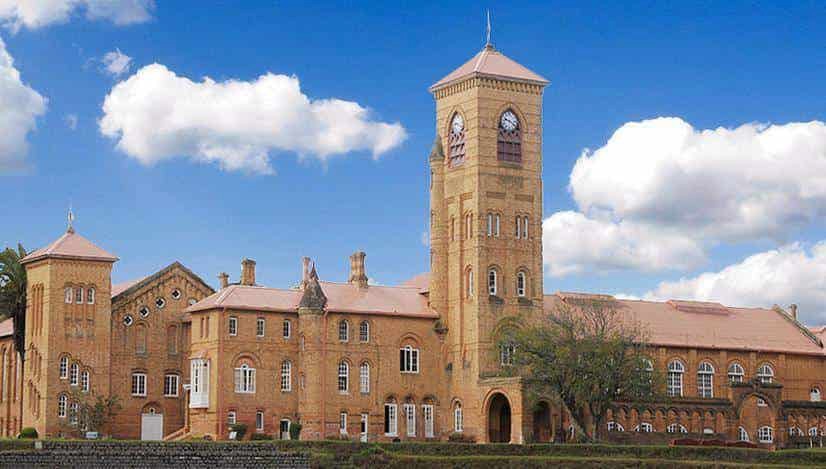DR. R. SIMPSON : PRINCIPAL 1933-1937. FAR AHEAD OF HIS TIMES?
Filling in the shoes of the Rev WHG Padfield was a huge challenge. An entire generation knew no other Principal of the Lawrence Memorial Royal Military School, Lovedale. The Rev Padfield had epitomized the school from 1908 to 1932 - nearly a quarter of a century.
The man who succeeded him turned out to be an achiever too. One who brought in a lot of progressive reform, particularly in the eyes of the students. He was the Rev R W Simpson, M Sc, D Phil (Oxon), FRES who took charge as the Principal in 1933.
In the picture below, Rev Simpson is seen with Sir Norman Marjoribanks KCIE, CSI, former Governor of Madras during his visit to Lovedale in 1934.
After his first year in office, Dr Simpson wrote, “ I felt at the beginning of the year soon after my arrival...that the Public School System of England....might be adopted to the needs of Lovedale School and after a full year of trial I feel more optimistic. The running of the School out of class hours is now practically entirely in the hands of the Prefects who have shouldered their responsibilities admirably.”
An Old Lawrencian remembered, " My last years at school took place under the ‘reign’ of Dr. Simpson who, in four short years, changed the whole concept of Lovedale’s development towards the ideals of a public school. Before his time it was run like an orphanage (and I should know!) Dr. Simpson (affectionately known as ‘Boss’) was responsible for (would you believe?) introducing crockery to replace ‘tin’ mugs and plates, the paneling of the dining hall (it used to look like a Victorian railway station), the building of flush toilets (they didn’t exist before), the introduction of baths (only showers before then), the building of chemistry, physics and biology labs and a host of other physical alterations, too numerous to mention here.”
He gave more emphasis to cultural activities and the students presented more plays including one in French- for the first time in Lovedale.
The Large Hall was renovated during this period as was the Church.
Another Old Lawrencian of those times recalled : " Well, he revolutionized the school. The food was dramatically improved, and so were the uniforms. Instead of eating off Aluminum plates and mugs we now had crockery imported from London, plates and mugs were of white china with blue rims and the school crescent on all the china. The girls had terrible uniforms of khaki! Black wool stockings and black boots . We now were dressed like English school girls, in brown tunics, cream blouses, and brown shoes and stockings - no more boots and no more khaki! "
The pictures below accentuate the point made by this OL.
Here's an account of Dr Simpson from an Old Lawrencian: "He was an outspoken man. For church services, instead of wearing the usual vestments he wore his red Oxford Doctor of Divinity Gown and looked very dramatic and imposing. Both Girls and Boys admired him enormously. We cried buckets when he was terminated. I remembered what the school was like before Dr. Simpson came and I was terrified that conditions would revert to the former Dickensian style. Remember the school was founded for orphan children of British soldiers (not officers) and the boys were encouraged to join the British army into the Boys Service - not as officers - and sent to Chepstow in Wales, England at the age of 14. Dr. Simpson wanted the boys to stay longer in school, get the Senior Cambridge, and be trained for the Indian Army as Officers."
It is said that Dr Simpson wanted to widen the scope of the school to include Indians amongst both staff and pupils. This apparently did not endear him to the Board of Governors of those days. There was also a controversy in his spending on items which they considered were not essential. Perhaps he wanted to bring about many changes too soon!
Dr Simpson resigned in 1937 after four years as the Principal of the school. Some believed his services had been terminated. It was obvious the students missed him terribly, less so the Board of Governors!
Writing of Dr Simpson 85 years after he left the School, we are left pondering : Was he far ahead of his times?
Pictures here are courtesy the Holdaway Family website and used with gratitude and with no commercial or profit motive whatsoever. "My Life Story" is a fascinating account of those times by Derek Holdaway, who is sadly no more. He studied in Lovedale from 1943 to 1948. His parents Walter Holdaway and Barbara Holdaway (nee Walton) were Old Lawrencians too and his mother was at school during the Simpson era.
Readers may also like to see Glimpses of A Glorious Past of August 2021 in the OL Assembly show.












